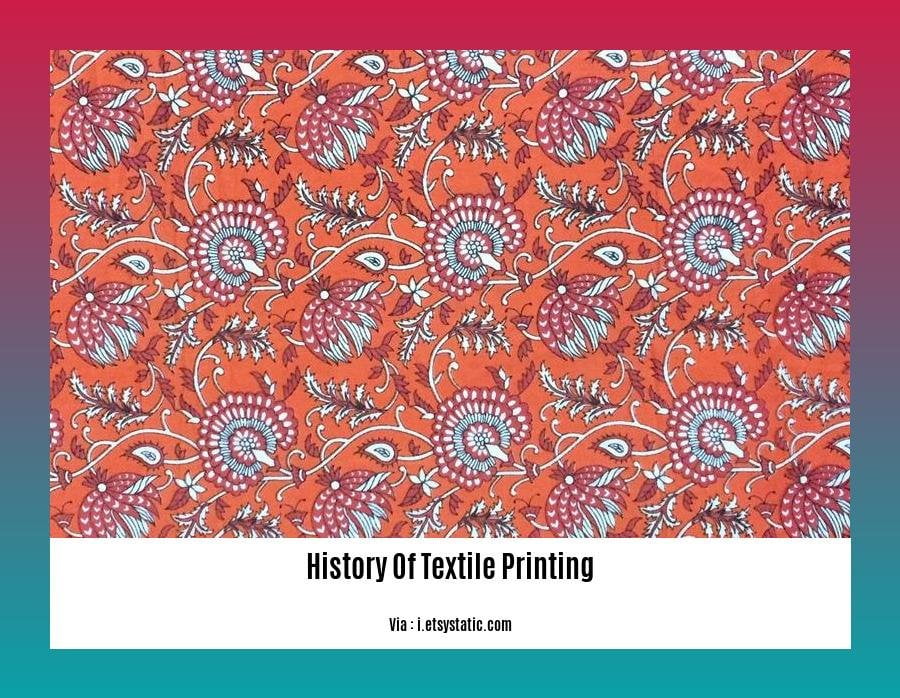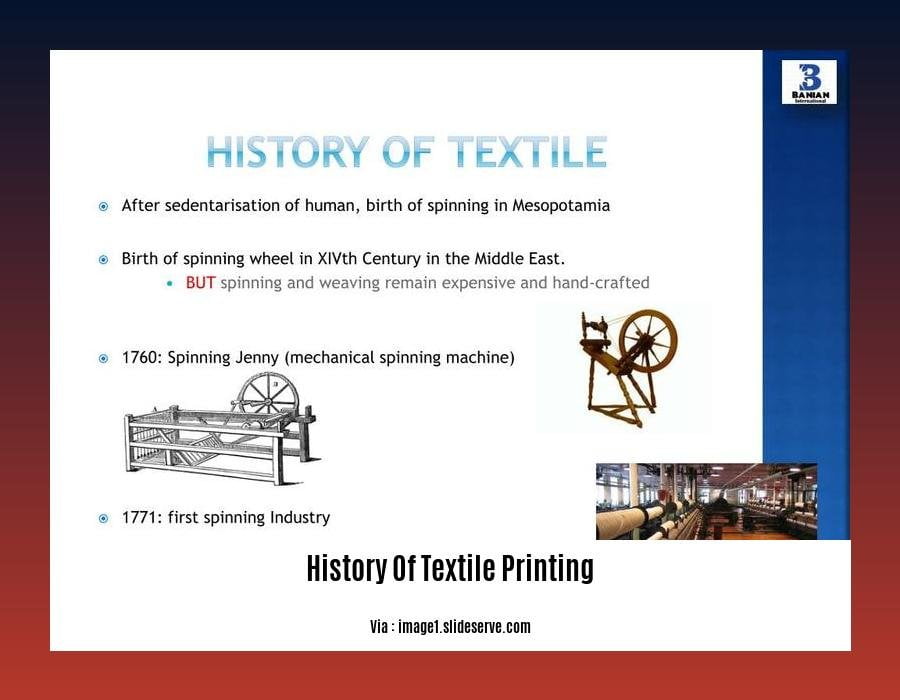Unleash the fascinating journey of textile printing, a mesmerizing blend of art, culture, and craftsmanship. From the ancient artisans of Asia to the global tapestry of designs, this article takes you on an intriguing adventure through the evolution of printed textiles. Prepare to delve into a world where fabrics tell stories, technologies transform industries, and vibrant patterns reflect the kaleidoscope of human creativity. Join us as we unveil the rich history of textile printing, a testament to the enduring power of human ingenuity.
Key Takeaways:
- Textile printing has ancient roots, dating back to before 220 CE/AD in China.
- Evidence of clay block printing on textiles exists from 1st-century Egypt.
- In India, printed textiles were produced as early as the 4th century BCE.
- Europe adopted textile printing in the 6th century, with designs primarily featuring repeated patterns.
- The introduction of paper from China led to the development of printing on paper, inspired by textile printing techniques.
History of Textile Printing

We are surrounded by captivating patterns and colors brought to life on textiles, a testament to the artistry and innovation of textile printing. Its rich history spans centuries, carrying tales of cultural exchange, technological breakthroughs, and artistic genius.
Ancient Roots
The history of textile printing stretches back to the ancient world, with early examples from China dating before 220 CE/AD. These early printers used carved wooden blocks to create intricate designs on cloth. In 1st-century Egypt, clay block printing emerged, adding to the repertoire of printing techniques. Meanwhile, in India, the 4th century BCE saw the creation of printed textiles, showcasing the diversity of printing traditions across the globe.
Europe’s Embrace
In the 6th century, textile printing made its way to Europe, initially featuring repeated decorative patterns. As paper was introduced from China, printing techniques developed on textiles influenced the development of printing on paper, fostering cross-pollination between these two mediums.
The Renaissance of Textiles
The European Renaissance witnessed a resurgence of textile printing, driven by artistic innovation and technological advancements. Artisans experimented with new techniques, including woodblock printing and engraving, allowing for more intricate and detailed designs. The Renaissance period laid the foundation for the vibrant textile printing industry that would flourish in centuries to come.
The Industrial Revolution’s Impact
The Industrial Revolution brought transformative changes to textile printing. The invention of the power loom and the development of synthetic dyes revolutionized the industry, enabling mass production and introducing a wider range of colors and patterns. These advancements made printed textiles more accessible, transforming fashion and home décor.
Modern Flourishing
In contemporary times, textile printing continues to thrive as an art form and an industry. Digital printing technologies have revolutionized the field, allowing for limitless design possibilities and on-demand production. Textile printing has found new applications in fashion, interior design, and even fine art, showcasing its versatility and enduring appeal.
As we delve deeper into the history of textile printing, we uncover a tapestry of artistry, innovation, and cultural exchange. From ancient artisans to modern-day designers, textile printing continues to captivate with its beauty, functionality, and boundless potential.
History of Taylormade Irons: Selling golf clubs since 1979, Taylormade has established itself as one of the most recognized manufacturers in the world. Look back on their incredible history.
History of the Bell: Inside the heart of the church, there is the bell tower that holds generations of history History of the Bell. Are you curious as to how far back its origin goes?
History of the Church Summary: Looking for a summary of the church’s rich history? Delve into a concise yet detailed overview of the church’s timeline.
Influence of cultural factors on textile printing, such as the incorporation of motifs and patterns from different regions.
Textiles bridge the worlds of art, culture, and craftsmanship, with patterns and motifs serving as emblems of heritage and storytelling. Cultural factors exert a profound influence on textile printing, fueling innovation and creativity among artisans worldwide. From the vibrant hues of Indian block prints to the intricate motifs of Japanese kimono, textiles mirror the fusion of history, tradition, and aesthetics that define a region.
Key Takeaways:
- Motifs and patterns hold symbolic meanings and serve as markers of cultural identity.
- Cultural exchange and globalization have facilitated the assimilation of patterns and motifs from diverse cultures.
- Textile printing techniques evolve to reflect unique cultural aesthetics.
- Regional variations in designs and motifs mirror traditional customs and lifestyle.
-
Textiles serve as a canvas for storytelling and preserving cultural heritage.
-
Motifs and patterns are a rich source of inspiration for contemporary fashion and design.
- Fusing motifs from different cultures fosters unity and mutual understanding.
- Cultural symbolism in textiles can often be traced back to ancient mythology and folklore.
- Textiles can act as a potent medium for expressing cultural and national pride.
- Preserving and promoting traditional textile crafts is vital for safeguarding cultural identity.
Cultural influences in textile printing are not merely decorative elements; they are the threads that weave together the rich tapestry of human expression.
Sources
– [The Cultural Background of Textile Designers] (
– [Cultural and Historical Analysis of Traditional Textile Motifs] (
Impact of technological advancements on textile printing, such as the mechanization of the printing process and the introduction of synthetic dyes.

Textile printing has undergone a remarkable evolution throughout history, and technological advancements have played a pivotal role in shaping its trajectory. Let’s explore the impact of these innovations on the world of textile printing:
Mechanization of the Printing Process
The mechanization of textile printing marked a significant turning point, shifting the industry from labor-intensive manual methods to efficient machine-driven processes. This transformation brought about numerous benefits:
-
Increased efficiency and productivity: Machines could print fabrics at a much faster rate compared to traditional hand-printing techniques, enabling mass production and meeting the growing demand for printed textiles.
-
Enhanced accuracy and precision: Machines provided greater control over the printing process, resulting in more precise and consistent designs and patterns. This accuracy was particularly crucial for intricate and detailed designs.
-
Expansion of design possibilities: Mechanization opened up new avenues for design exploration. Designers could now create complex patterns and motifs that were previously impractical or impossible to achieve by hand.
Introduction of Synthetic Dyes
The advent of synthetic dyes further revolutionized the textile printing industry. These dyes, derived from chemical compounds, offered several advantages over natural dyes:
-
Wider color spectrum: Synthetic dyes provided a vastly expanded range of colors compared to natural dyes. This diversity allowed for more vibrant, intense, and varied designs.
-
Improved colorfastness: Synthetic dyes exhibited superior resistance to fading and washing, ensuring that printed textiles retained their colors even after multiple uses and cleaning.
-
Affordability: Synthetic dyes were generally more cost-effective to produce compared to natural dyes, making printed textiles more accessible to a wider consumer base.
The convergence of mechanization and the introduction of synthetic dyes propelled textile printing into a new era of innovation and creativity. These technological advancements not only transformed the production process but also influenced the aesthetics and availability of printed textiles, shaping the industry as we know it today.
Key Takeaways:
-
Mechanization of the printing process brought increased efficiency, precision, and expanded design possibilities.
-
The introduction of synthetic dyes offered a wider color spectrum, improved colorfastness, and affordability.
-
Technological advancements revolutionized the textile printing industry, leading to mass production, enhanced quality, and greater design diversity.
-
Textile printing evolved from a labor-intensive craft to a modern, technology-driven industry, impacting fashion, interior design, and various other fields.
References:
[1] Uddin, M. H., & Islam, M. R. (2020). Digital printing of textiles: A review. Journal of the Textile Association, 81(1), 10-18.
[2] Hu, J., & Li, X. (2023). Advances in digital textile printing technology. In Digital textile printing (pp. 1-32). Woodhead Publishing.
Role of textile printing in fashion and society, including its use in clothing, home furnishings, and other decorative items.
Textile printing is an ancient artwork that has touched every corner of the fashion and decor industry. Let’s explore its fascinating history and global impact:
A Timeless Tale of Textile Printing
Textile printing’s roots can be traced back to ancient civilizations like China and India. Early techniques involved hand-painting, block printing, and stenciling to create vibrant hues on fabrics. Over time, printing spread to Egypt, Persia, and Europe, influencing local designs and styles.
Cultural Canvas
Textile printing played a crucial role in cultural expression. Motifs and patterns were inspired by nature, local folklore, and religious beliefs. In India, for instance, intricate paisley prints symbolized prosperity, and in Japan, cherry blossom prints evoked the beauty of springtime.
Fashion Forward
With the advent of mechanization during the Industrial Revolution, textile printing became more accessible and affordable. Mass-produced printed fabrics revolutionized the fashion industry, allowing for the creation of colorful and intricate clothing designs.
Home Decor Haven
Textile printing brought a burst of color and personality to home interiors. Printed curtains, upholstery, tablecloths, and bed linens transformed living spaces into cozy and stylish havens.
Beyond Aesthetics
Textile printing had practical applications too. Printed labels, for example, helped identify different bolts of fabric, and printed instructions on clothing provided care information.
Key Takeaways:
- Textile printing has a rich history that spans different cultures and civilizations.
- It has served both functional and decorative purposes in fashion, home furnishings, and various decorative items.
- Textile printing allowed for mass customization, making it a powerful tool for personal expression and cultural representation.
- The industry has evolved with technological advancements, from hand-printing to digital printing, offering endless possibilities for design creation.
- Textile printing remains a vibrant and integral part of our daily lives, enriching our fashion and decor choices.
Sources:
[1] https://www.britannica.com/topic/textile/Printing
[2] https://fashion2apparel.com/textile-printing-and-its-importance-in-fashion-industry/
FAQ
Q1: How did textile printing originate?
A1: The origins of textile printing can be traced back to ancient China, where clay block printing was used to create intricate designs on fabrics as early as the 1st century CE.
Q2: What were the prevalent textile printing techniques in ancient times?
A2: In ancient Egypt, clay block printing was widely used for textile decoration. In India, evidence suggests the use of printing techniques for textiles as early as the 4th century BCE.
Q3: How did textile printing spread to Europe?
A3: Textile printing reached Europe in the 6th century, influenced by trade routes and cultural exchanges with the Middle East and Asia.
Q4: How did the development of paper impact textile printing?
A4: The introduction of papermaking techniques from China led to the development of printing on paper, which adapted and borrowed from existing textile printing practices.
Q5: How has textile printing evolved in the digital age?
A5: The rise of digital technology has revolutionized textile printing, enabling precise, high-quality, and sustainable printing methods such as digital inkjet printing, which has gained traction due to its reduced environmental impact and design flexibility.
- Unveiling the Enigma: Mansoureh Khojasteh Bagherzadeh’s Public Appearances & Private Life in Iran - July 18, 2025
- Unveiling the Mystery: Mansoureh Khojasteh Bagherzadeh’s Husband: A Rare Glimpse into a Private Life - July 18, 2025
- Unveiling Masoud Khamenei’s Mother: Power, Influence, and Iran’s Future - July 18, 2025





![A Stitch in Time: Exploring the Evolution of Clothing in India Through the Millennia [clothing in india history] clothing-in-india-history_2](https://www.lolaapp.com/wp-content/uploads/2023/12/clothing-in-india-history_2-150x150.jpg)










